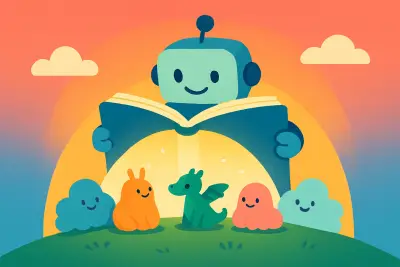Are AI Story Books Safe for Kindergarten Children? 🤖📚
As technology continues to seep into every corner of our lives, it has now made its way into storytelling for children. AI story books are on the rise, offering unique narratives tailored to young readers. But are they really safe for kindergarten children? In this article, we'll unpack the pros and cons of AI story books and help you make an informed decision for your little ones.
What are AI Story Books? 📖✨
AI story books leverage artificial intelligence to generate engaging, personalized stories based on children's preferences. Imagine a book that adapts to your child's interests, creating an exciting narrative every time they read! With platforms like AI Story Book, parents can choose from a myriad of themes—educational, entertaining, and adventurous.
Benefits of AI Story Books 🌟
Customization:
- Stories can be tailored to fit the child’s interests and reading levels.
- This personalization keeps children engaged and encourages a love for reading.
Creativity Boost:
- AI story books stimulate a child’s imagination with unique plots.
- Encourages children to come up with their own stories based on what they read.
Interactive Experience:
- Many AI story platforms offer interactive elements, enhancing the reading experience.
- Children can even choose different paths in the narrative, making it feel like a game!
Accessibility:
- AI story books are available anytime, anywhere—perfect for busy families.
- Ideal for parents looking for quick and educational activities to share.
Potential Concerns About AI Story Books ⚠️
While the benefits are clear, it’s essential to discuss the potential concerns associated with AI story books.
Content Quality:
- AI-generated stories may not always follow traditional narratives, which can be confusing for young readers.
- Ensuring quality control is necessary; parents should review stories before sharing them.
Screen Time:
- AI story books often involve some form of digital device, which raises questions about screen time limits.
- Monitoring usage is crucial to ensure a healthy balance.
Social Interaction:
- Reading stories together helps build communication skills—AI may miss that personal touch.
- Engage in discussions about the stories; it’s essential for emotional development.
Safety and Privacy:
- As with any online product, safety and privacy are valid concerns.
- Always check the privacy policy of the platform you use and ensure it’s child-friendly.
Best Practices for Using AI Story Books with Kids 👶📲
To maximize the positive impacts and minimize any risks associated with AI story books, consider these best practices:
Review the Content:
- Always preview stories for age-appropriateness before letting kids read them independently.
Set Limits:
- Balance digital reading with traditional books and other activities to encourage well-rounded development.
Parental Involvement:
- Engage with your child while they read; ask questions about the plot and characters to enhance comprehension.
Choose Reputable Platforms:
- Opt for platforms like AI Story Book that prioritize safety and educational value.
Encourage Creativity:
- After reading, prompt your child to create their own stories or endings inspired by what they just read.
Conclusion: Are AI Story Books a Good Fit? 🤔
AI story books can be a valuable addition to your child’s reading journey when used responsibly. They offer exciting opportunities for engagement and creativity. However, it's crucial to remain vigilant about content quality and screen time.
By sticking to reputable platforms, maintaining an active parental role, and setting limits, you can ensure that AI story books are both a safe and enjoyable reading choice for kindergarten children.
Looking for a fantastic AI story book experience? Check out AI Story Book today and watch your child’s imagination soar!
AI story books, kindergarten children, are AI story books safe, personalized stories, children’s reading, interactive reading experience, benefits of AI, storytelling for kids, educational tools for children, screen time for kids, engage children in reading.
